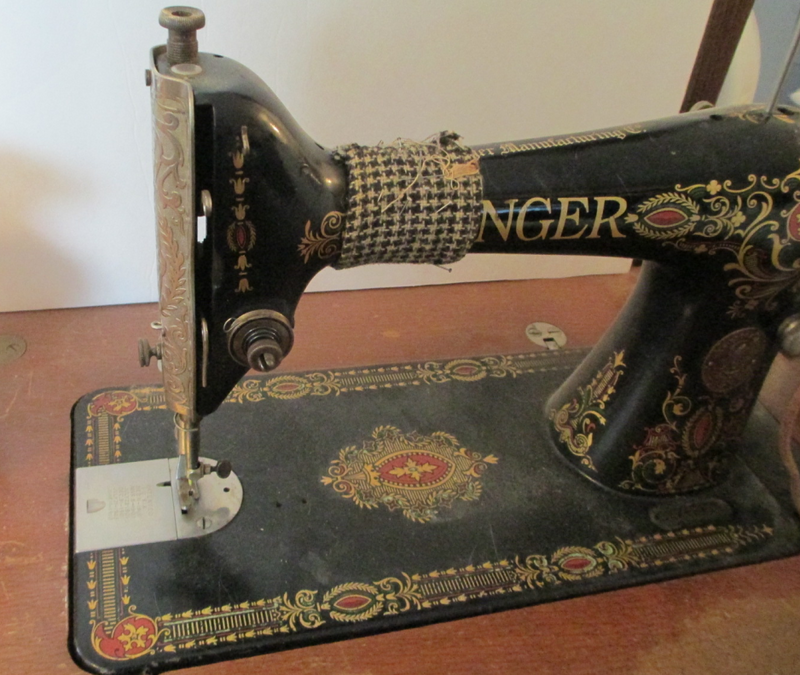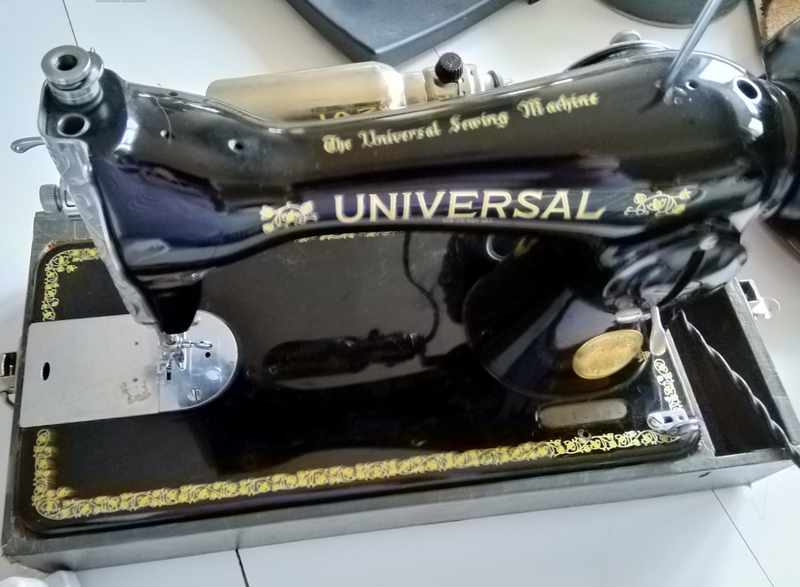Buying a sewing machine

I get asked “What sewing machine should I buy?” a lot, so I’m going to compile all my recommendations in one place.
The short answer, if you want to go right out and grab an inexpensive, general-purpose machine, is probably one of the colorful little Janomes that you can usually find at JoAnn and some other chains. For example, right now this critter is $110: https://www.joann.com/janome-easy-to-use-sewing-machine-blue-couture/15966112.html. “New Home” is a brand Janome acquired back in the 60’s; I’m never quite sure what the collective model name is for that series. As far as I know the colors are all the same, feature-wise, and if that listing is sold out poke around on the site or in your local store because they’re all listed individually and the colors change with trends.
There’s also a compact version that I think is what I got my kid when they were smaller; it’s a very good little machine too and only runs $70 right now: https://www.joann.com/janome-derby-portable-sewing-machine–purple-thunder/13519350.html. It has ten stitches to the larger machine’s 15, which is probably still at least five more stitches than you’ll ever use.
I’m also going to point you to Wirecutter’s advice which I don’t entirely agree with as beginner picks, but if you’re willing to start out in that price range those are solid choices. (None of my recommendations here are affiliate links, by the way, but Wirecutter’s will be. For them, not me.)
Now for the longer answer: it’s complicated.
Buy used if you can. A lot of people buy sewing machines and don’t use them. Like, a lot. You can find wonderful workhorse machines at estate sales, in thrift shops, everywhere. Some quilt shops are also dealers and sell their trade-ins very reasonably, figuring they’ll make it back in fabric sales later.
Postwar-Japan Singer 15 clones are works of art, are indestructible, and if they did zigzag they’d be all I ever recommended anyone use, but that wasn’t a thing until the late 50’s (and the clones are from expired patents). They’re heavy - with case, my “portable” clone is close to forty pounds - but they’re beautiful, and if you find an antique dealer who isn’t trying to sell them to people who think they’ve found a turn-of-the-century treasure, affordable.

(You can’t see it in this picture, but there’s an external electric motor on the back with a belt that drives this post-war machine just like the treadle belt drove its clone-parent. I actually got this machine as a donor in case the treadle Red-Eye, in the featured image, needed parts or was irreparable.)
You probably want something with more features, though, and a good-quality mid-century mechanical sewing machine is probably out there waiting for you, you just have to do some looking.
Features to look for
Sewing machines are somewhat specialized, more so when you get into garmentmaking. Which, in case you haven’t been around here much, isn’t something I do much of. And never, when it comes to actual fashion, which is an entirely different animal. I learned a good deal about the home version, but in the 70’s so it was all polyester knits and no computerized machines (though we had a cam-driven mechanical monogrammer for our Singer). So your needs will be different if you sew plushies versus clothes. Here are some features that are important for different types of sewing:
- Variable speed: The pedal is usually like a car’s gas pedal, running the motor at a faster speed the further down you push it. But not always, and some machines are better at speed control than others. This is pretty important, especially on a fast machine - you want to be able to control it closely at low speeds, when doing precise sewing for odd plushie shapes or garment details.
- Speed vs. power: When I needed to replace the Singer, I told the dealer I needed an industrial machine but couldn’t afford an industrial machine. He asked if I needed the industrial’s speed or its power and I said the latter, and that is exactly what I got. I sewed a patchwork jeans quilt that sometimes had eight layers of denim and it didn’t blink, but also it took forever on those long seams because it never sped up, either. On the other hand, my mother’s Designer I is lightning-quick and disturbingly precise. Some machines are draft horses, others are racehorses. (Low-end machines are ponies, I guess?)
- Presser-foot compatibility: You’ll eventually want allllll the specialty feet if you’re sewing garments, and you’ll still want at minimum a regular and zipper foot (which has uses far beyond zippers). Some machines require their own brand of feet, but there’s a standard (Singer? I don’t really know) attachment type that you really want to have. My Viking has quick-change feet which are super-convenient, but they all mount to a base that itself has the standard way of attaching to the presser foot bar. This means I don’t have to buy an expensive Viking-only walking foot or whatever, if I don’t mind unscrewing it instead of just snapping it in.
- Bobbin compatibility: Some machines use proprietary bobbins. By far the most common is the classic Singer Class 15 bobbin - sometimes it’s an adventure figuring out if a machine’s bobbin is really just a different name for a 15. For instance, both my embroidery machines say they require brand-name bobbins, but they’re both just plastic versions of a Class 15. (Plastic is lighter-weight; the old metal style will work only if I slow them down to sewing-machine speeds. Using plastic bobbins in a metal-bobbin machine is fine.) Truly proprietary bobbins can be a pain: Viking sewing machine uses one type of Viking bobbins, my Viking embroidery machine uses another.
- Free-arm: if you’re sewing cuffs and hems on sleeves, a free-arm will let you sew from the top instead of having the rest of the sleeve flapping around getting caught in the needle bar (the up-and-down assembly with the needle at the business end). It’s also useful for sewing dice bag tops, and occasionally plushies, but it’s an absolute must for any kind of shirt-making. Most free-arms have a piece that removes to free up the arm but also gives you a flat table area.
- Variable presser foot pressure: If you’re sewing on minky or faux fur, you’re putting a much thicker amount of fabric through than if you’re sewing quilting cotton. If you can’t lighten up the presser foot, it’ll tend to smush the top piece back into place while pulling the bottom piece through, and you’ll get seams that pull one direction or another. If you’re just sewing garment fabrics this is less of a problem, at least until you get into coat fabrics and whatnot.
- Feed dog drop: The feed dogs (little grippy bits that grab the fabric against the pressure foot from below and work the fabric through as it stitches) can be adjusted or dropped completely on some machines. The latter is absolutely essential if you want to do free-motion quilting or thread-painting. If you don’t, you will not even be able to tell your blog readers which of your machines can do that. (Look, that’s what I have embroidery machines for.)
- Zigzag stitch: The really old machines are straight-stitch only. No buttonholes, no satin-stitch around appliques, etc. Obviously my grandmothers and maybe yours did just fine sewing clothes and quilts for themselves and all their family members with straight-stitch only, so if you’re not afraid of a little hand-work on buttonholes (or you plan to get by with zippers and velcro) you can too. And you don’t need anything but straight stitch to sew plushies.
- Buttonholes: These are the worst. All you really need to do buttonholes is a zigzag stitch, but they’re tedious, and until you’re very familiar with your machine it’s hard to make them consistent. If you expect to do a lot of them, it’s probably worth getting a machine that has the magic thingy that sizes your button and does it for you (the Wirecutter article talks about this), but even that little Blue Couture Janome has the basic four-step settings. Or, again, put on an audiobook and hand-bind your buttonholes.
- Stitch types: If you’re going to do a lot of garmentmaking, you’ll eventually want a serger/overlocker. That’s what makes the little enclosed-by-a-web-of-threads seams. (Look inside your clothes right now, you’ll recognize them.) But if you’re not there yet, you may still want something that can kind-of finish the raw edges, so it doesn’t scream “homemade!” but also just to cut down on fraying and increase your garment’s life. Some machines come with a faux-overlock stitch. Other, embellishment-type stitching is generally less useful - if you can’t picture what you’d use a stitch for, you probably won’t.
- Throat size: Most of the time, you sew with your work on the left of the needle, and just the seam allowance to the right. But sometimes you’re top-stitching, or quilting, or something else that involves going down the middle of the work. When that happens, you have to be able to get it through the enclosed space between the needle and the whole rest of the mechanicals. Here’s where the portables and three-quarter-size machines are a problem, and why long-arm quilting machines exist. This doesn’t come up too often, but if you expect to do a bunch of quilting (even just panels for bags and whatnot), don’t get a machine that’s going to choke on it.
- Metal bodies vs. plastic: The frame of the machine is generally (always?) metal, but some people really despise plastic-bodied machines. I get that: my Viking has a broken cover hinge, and I don’t take it many places. If you have to schlep the machine from storage to the kitchen table every time you want to use it, you’ll have to consider weight versus durability.
- Electronics: The mechanicals are the important part, electronics are just there to break. Leave ‘em for the embroidery machines.
- Brand names: This gets complicated fast, because you have to know the age of a machine to really know whether its brand is any good. Singer used to be a gold standard, but the brand name has been sold (along with Viking and Pfaff) to a private equity firm, and they make low-end machines now. But if you’re getting a thrifted machine, you’re probably fine with any of the big brands (if you’re not familiar with sewing machine brands, a quick duckduck will tell you if a machine you’re looking at was popular, and if/when the brand name was sold off, and you may even be able to find a registry of serial numbers that will tell you exactly how old a machine is).
Have I left anything out? Give a shout in the comments below.
